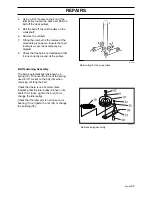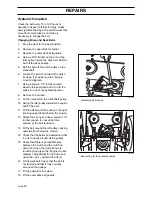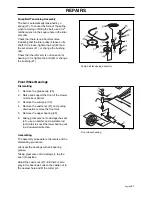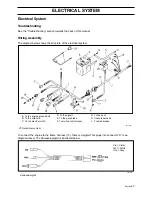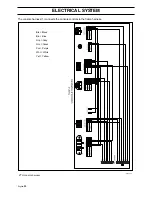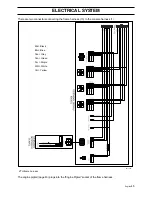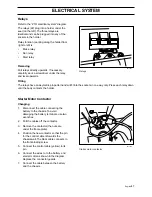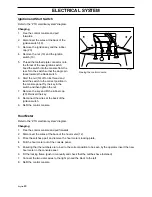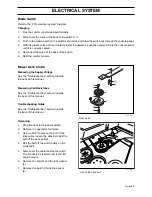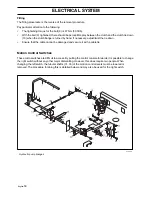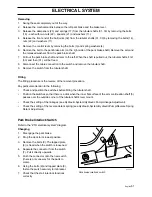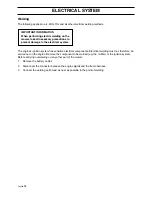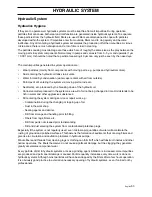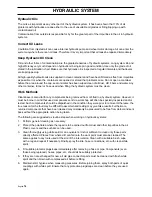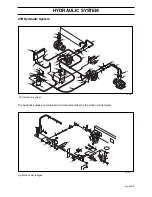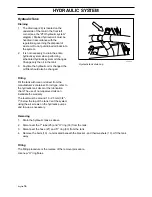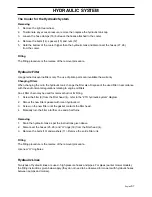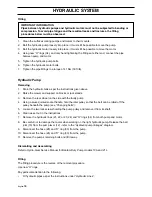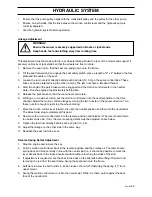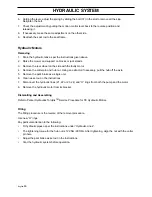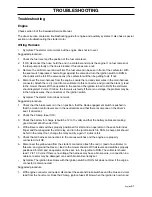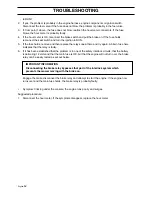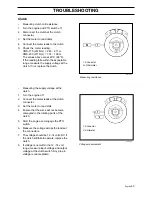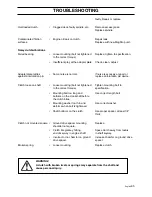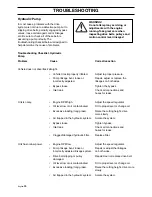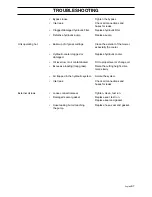
English-
53
HYDRAULIC SYSTEM
Hydraulic System
Hydraulics Hygiene
If they are to operate well, hydraulic systems must be kept free from all impurities. During operation,
particles that can cause both wear and malfunction are generated inside hydraulic systems. To separate
these particles from the hydraulic fluid, filters are used. Filters are dimensioned to cope with particles
developed within the system. If impurities enter from outside, filters tend to clog quickly and become
ineffective. Any dirt entering a hydraulic system accelerates the production of further impurities. A vicious
circle arises; there is much disruption and a lot of time is lost in cleaning.
The particles causing most damage are those which are of roughly the same size as the play between the
moving parts in system components. Normal play in pumps and valves is from 3 - 5 µm and upwards (1 µm
= 0.001 mm). It should be noted that a particle measuring 40 µm can only just be seen by the naked eye.
The main impurities generated in system operation are:
•
Wear particles (mainly from components with moving parts, e.g. pumps and hydraulic motors).
•
Dust entering the hydraulic oil tank via air vents.
•
Water formed by condensation (water vapor enters with air from outside).
•
Particles of dirt entering the system via moving piston rods, etc.
•
Sediments, etc. produced by the breaking down of the hydraulic oil.
•
Corrosive matter produced in the system as a result of oil not being changed in time. Old oil tends to be
rich in water and other aggressive substances.
•
Dirt entering the system during service or repair work, e.g.:
- Contamination during the changing or topping-up of oil.
- Dust in the workshop.
- Sealing agents and similar.
- Dirt from storage and handling prior to fitting.
- Fibers from rags, filters, etc.
- Dirt from parts not cleaned prior to dismantling.
- Dirt and dust entering the system from contaminated protective plugs.
Especially if the system is not regularly used, even microscopic quantities of water will accelerate the
rusting of ground and polished surfaces. This hastens the formation of sediments that can clog filters and
give rise to circulation and cavitation problems in hydraulic pumps.
Minute fibers and threads from cleaning rags or clothing can form fluff which will obstruct nozzles and other
narrow apertures. The fibers themselve do not cause significant damage, but the clogging they generate
greatly accelerates component wear.
Every particle of dirt in hydraulic systems acts as a grinding agent. Abrasion is increased, more impurities
are produced and permanent damage is caused. Particle quantity increases every time work is done on
hydraulic systems. Although most particles will have been trapped by the filters after a few hours operation,
it is obviously good practice to avoid all unnecessary opening of hydraulic systems, even if carried out by
professionals.
Summary of Contents for ZTH5223
Page 1: ...Workshop manual ZTH English ...
Page 2: ...Svenska 31 ...
Page 4: ...English 2 ...
Page 12: ...English 10 TECHNICAL DATA ...
Page 20: ...English 18 DELIVERY AND DEALER SERVICE ...
Page 44: ...English 42 REPAIRS ...
Page 70: ... H 6D ...
Page 71: ...Svenska 31 ...
Page 72: ...114 00 80 26 2002W20 H 6D ...

